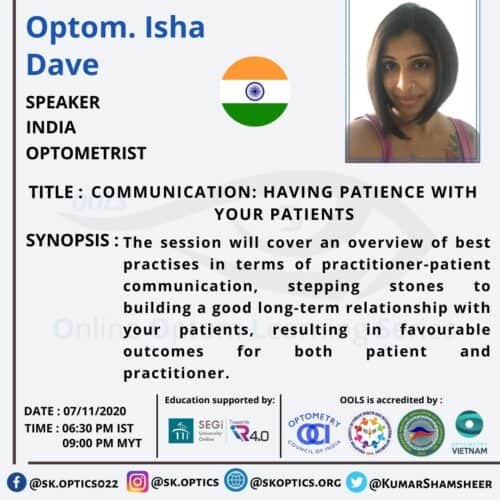
Isha Dave, a practicing optometrist and an optometry educator begins by informing us that communication may be subjective and personality dependent. But, we learn about specific tips that would help us communicate better with our patients. We are introduced to the concept of ‘white-coat hypertension’ a phenomenon that affects patients when they come to see the doctor.
To understand the doctor patient relationship we go back to ancient Egypt and see how the doctor patient relationship has changed overtime all the way to the present day.There are two types of relationship model between patient and practitioner:
- Medical centric
- Patient centric
We delve into the details of how the patient centric model of communication is beneficial for the patient and the practitioner. The following are some attributes we need keep in mind to make the patient comfortable.
- Courtesy
- Reassurance
- Support
- Friendliness
- Encoragement
- Empathy
- Cognitive
- Emotional
- Compassionate
To communicate effectively, we must keep the following points in mind:
- Assess patient knowledge
- Assess patients needs and wants
- Be empathic
- Slow down and listen
- Adapt your language to suit the patient
- Be truthful
- Be hopeful
- Be aware of patient body language
- Be ready for patient reaction
Non-verbal communication is also very important and following are some attributes that we must keep in mind:
- Silence
- Body language
- Facial expression
There are some communication issues that we must avoid
- Avoid using jargons
- Not showing concern
- Not pausing
- Not verifying that the patient has understood
- Being apathetic
- Not being available
We learn about some tips to improve our daily practice in primary eye care. We use the ‘SOAPE’ to review how to communicate during each step of our primary eye care examination.
- Subjective
- Objective
- Give clear instructions
- Keep the patient informed throughout the examination
- Keep checking in and reassuring
- Assessment
- Plan
- Education
In conclusion, we get some overall tips for communicating better with our patients. The session ends with an informative Q and A session with the audience.
